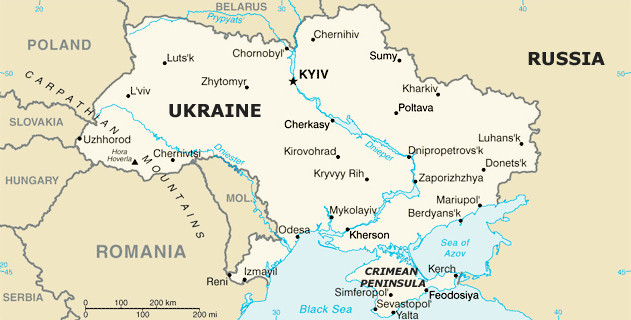Ukraine Famine Monument Erected In Washington

(RFE/RL – Tony Wesolowsky – August 6, 2015)
After years of work and some setbacks, a memorial to the millions who perished in the Ukraine famine of the 1930s, or Holodomor, has been erected in the U.S. capital.
The monument — a bronze slab resting on a stone plinth and showing a field of wheat stalks — was winched off the trailer of a truck and bolted into place in downtown Washington on August 4.
On hand were Ukrainian Ambassador to the United States Valeriy Chaly and the sculpture’s Ukrainian-American designer, Larysa Kurylas.
Tamara Olexy, the president of the Ukrainian Congress Committee of America, which helped spearhead efforts to bring the project to fruition, described the moment as “very significant” for the Ukrainian community in the United States and elsewhere, capping years of hard work.
In an interview with RFE/RL, Olexy said she hopes the monument will raise awareness of what Ukrainians consider their greatest tragedy.
“We hope the world, and the greater community here in the United States as well, will understand the significance of what happened in Ukraine in 1932 and 1933 when up to 7 to 10 million Ukrainians — men, women, and children — were starved to death under Stalin,” Olexy explained.
An official unveiling ceremony for the Field of Wheat memorial is scheduled to take place on November 7.
Efforts to construct the memorial gained traction in 2006 when the U.S. Congress gave its approval to the project in cooperation with the authorities in Kyiv.
By that time, Ukraine’s Orange Revolution had led to the election of Viktor Yushchenko as president.
Eager to reawaken Ukrainian patriotism long suppressed under Soviet rule, Yushchenko sought to raise international awareness of the Holodomor, which means “death by hunger.”
Under Yushchenko, a Holodomor memorial and museum opened in Kyiv in 2009. Shortly thereafter, Ukraine’s Culture Ministry launched an international competition to pick a sculptor for the Washington memorial.
Two years later, in 2011, the U.S. Commission of Fine Arts chose Kurylas’s entry, Field of Wheat.
The U.S. Congress allocated the plot where the monument now sits on a triangular sliver of federal land bounded by Massachusetts Avenue, North Capitol Street, and F Street, but not money. Funds for the project have come from private donors, both individuals and organizations.
‘Political Weapon’
The 10-meter-long strip of bronze depicts almost sinewy wheat stalks that first project then gradually recede across the monument. That is meant to represent the withering away of the harvest bounty to famine scarcity. Beneath “Famine-Genocide in Ukraine”, text is provided off to the side in both English and Ukrainian giving brief, basic facts of the Ukraine famine .
To Kurylas, “Wheat was used as a political weapon to starve the people of Ukraine,” she told the Washington Post last year.
Historians say the seizure of the 1932 crop in Ukraine by Soviet authorities was the main cause of the famine. Moscow has long denied any systematic effort to target Ukrainians, arguing a poor harvest at the time wiped out many in other parts of the then Soviet Union.
Given her ethnic Ukrainian roots, Kurylas, an architect by trade, said the project was the most important work she had ever done.
“It has a spiritual dimension,” she told the Post.
To make sure she got the details right, Kurylas said she visited a relative’s farm in Winnipeg, Canada to examine wheat stalks up close.
Kurylas joins a small group of women who have designed modern-day memorials in Washington, joining Maya Lin, who designed the Vietnam Veterans Memorial, and Julie Beckman, who along with husband Keith Kaseman, designed the National 9/11 Pentagon Memorial.
There has been some controversary surrounding the monument, which went up as Ukraine struggles with Russian-backed separatists whose war with government forces has killed more than 6,400 people since April 2014. The conflict and Russia’s annexation of Crimea from Ukraine have severely strained ties between Washington and Moscow.
Among the individuals contributing financially was Dmytro Firtash, a Ukrainian gas tycoon who was arrested in Austria in 2014 on bribery charges, at the request of U.S. authorities. He was later released on bail and a Vienna court rejected a U.S. request for his extradition in April.
Firtash, who denies any wrongdoing, gave $2.5 million to the memorial project.
Ukraine’s recent turbulent political shifts have also put the project on shaky footing at times.
When Kurylas’s entry was selected in 2011, Viktor Yanukovych was in power after defeating Yushchenko in the 2010 presidential election. Eager to please the Kremlin, the now-ousted Yanukovych reversed Yushchenko’s stance on the famine, saying it was “wrong” and “unjust” to call it a genocide.
Olexy said the Ukrainian community in the United States and elsewhere remained focused on the issue despite the challenges.
“We had to plug through there is nothing you can do about it because this issue has been extremely important to the Ukrainian community since it actually happened in the 1930s,” Olexy said.
“We had major demonstrations in the 30s. The women’s organization, the Ukrainian National Women’s League of America, had demonstrations in New York City back in the 30s trying to raise awareness of what was going on in Ukraine and we’ve been bringing up this issue ever since.”
Article from Radio Free Europe/Radio Liberty – rferl.org – ©2015 RFE/RL, Inc. Article also appeared at rferl.org/content/ukraine-famine-monument-erected-in-washington/27174009.html
